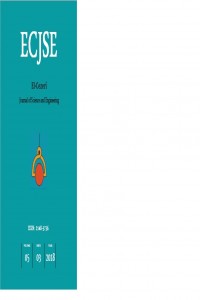E-Cam Elyaf Takviyeli Epoksi Matrisli Kompozit Malzemelerin Elyaf Oranındaki Artış İle Mekanik Özelliklerindeki Değişimlerin İncelenmesi
Abstract
Cam elyaf
takviyeli polimer matrisli kompozit malzemeler endüstride, otomotiv sanayinde,
inşaat ve diğer birçok alanda kullanılmakta olan mühendislik malzemeleridir. Bu
malzemeler matris yapısını oluşturan bir polimer reçinesi içerisine cam
elyafların eklenmesi sonucunda elde edilmektedir. Bu çalışmada vakum destekli
reçine transfer metodu ile üretilen ile değişik elyaf oranlarına sahip (hacimce
%30, %40, %50 ve %60) kompozit malzemeler hazırlanmış ve bu malzemelerin
mekanik özellikleri incelenmiştir. Bu kompozitlerin üretiminde matris malzemesi
olarak Epikote 828 epoksi reçinesi kullanılmıştır. Elde edilen plaka halindeki
kompozit malzemelerden ASTM standartlarına uygun olarak numuneler kesilerek
çekme, darbe ve üç nokta eğme deneyleri gerçekleştirilmiştir. Tüm bu
çalışmaların sonucunda cam elyaf oranının artmasıyla birlikte kompozit
malzemenin maksimum gerilme, çekme uzama, elastik modülü ve darbe dayanımı
özelliklerinin yükseldiği gözlemlenmiştir.
Keywords
References
- [1] Sanjay M.R., Arpitha G.R. & B. Yogesha, Study on Mechanical Properties of Natural - Glass Fibre Reinforced Polymer Hybrid Composites: A Review, Materials Today: Proceedings 2 ( 2015 ) 2959 – 2967
- [2] Post W, Cohades AM, Michaud V, van der Zwaag S, García SJ, Healing of a glass fibre reinforced composite with a disulphide containing organic-inorganic epoxy matrix, Composites Science and Technology (2017)
- [3] Abdullah Al Mahmood, Abdul Mobin, Rezwon Morshed, Tasmia Zaman, Characterization of Glass Fibre Reinforced Polymer Composite Prepared by Hand Layup Method, American Journal of Bioscience and Bioengineering. Vol. 5, No. 1, 2017, pp. 8-11.
- [4] Patil Deogonda, Vijaykumar N Chalwa, Mechanical Property of Glass Fiber ReinforcementEpoxy Composites, International Journal of Scientific Engineering and Research (IJSER) Volume 1 Issue 4, December 2013
- [5] S. Basavarajappa, K.V. Arun, J. Paulo Davim, Effect of Filler Materials on Dry Sliding Wear Behavior of Polymer Matrix Composites – A Taguchi Approach, Journal of Minerals & Materials Characterization & Engineering, Vol. 8, No.5, pp 379-391, 2009
- [6] Kishore, P. Sampathkumaran, S. Seetharamu, S. Vynatheya, A. Murali, R.K. Kumar, SEM observations of the effects of velocity and load on the sliding wear characteristics of glass fabric–epoxy composites with different fillers, Wear 237 _2000. 20–27
- [7] B. Suresha, G. Chandramohan1, J. N. Prakash, V. Balusamy and K.Sankaranarayanasamy, The Role of Fillers on Friction and Slide Wear Characteristics in Glass-Epoxy Composite Systems, Journal of Minerals & Materials Characterization & Engineering, Vol. 5, No.1, pp 87-101, 2006
- [8] Ricciardi MR, Papa I, Langella A, Langella T, Lopresto V, Antonucci V, Mechanical properties of glass fibre composites based on nitrile rubber toughened modified epoxy resin,Composites Part B (2018)
- [9] L.B. Manfredi, H. De Santis, A. Vázquez, Influence of the addition of montmorillonite to the matrix of unidirectional glass fibre/epoxy composites on their mechanical and water absorption properties, Composites: Part A 39 (2008) 1726–1731
Abstract
References
- [1] Sanjay M.R., Arpitha G.R. & B. Yogesha, Study on Mechanical Properties of Natural - Glass Fibre Reinforced Polymer Hybrid Composites: A Review, Materials Today: Proceedings 2 ( 2015 ) 2959 – 2967
- [2] Post W, Cohades AM, Michaud V, van der Zwaag S, García SJ, Healing of a glass fibre reinforced composite with a disulphide containing organic-inorganic epoxy matrix, Composites Science and Technology (2017)
- [3] Abdullah Al Mahmood, Abdul Mobin, Rezwon Morshed, Tasmia Zaman, Characterization of Glass Fibre Reinforced Polymer Composite Prepared by Hand Layup Method, American Journal of Bioscience and Bioengineering. Vol. 5, No. 1, 2017, pp. 8-11.
- [4] Patil Deogonda, Vijaykumar N Chalwa, Mechanical Property of Glass Fiber ReinforcementEpoxy Composites, International Journal of Scientific Engineering and Research (IJSER) Volume 1 Issue 4, December 2013
- [5] S. Basavarajappa, K.V. Arun, J. Paulo Davim, Effect of Filler Materials on Dry Sliding Wear Behavior of Polymer Matrix Composites – A Taguchi Approach, Journal of Minerals & Materials Characterization & Engineering, Vol. 8, No.5, pp 379-391, 2009
- [6] Kishore, P. Sampathkumaran, S. Seetharamu, S. Vynatheya, A. Murali, R.K. Kumar, SEM observations of the effects of velocity and load on the sliding wear characteristics of glass fabric–epoxy composites with different fillers, Wear 237 _2000. 20–27
- [7] B. Suresha, G. Chandramohan1, J. N. Prakash, V. Balusamy and K.Sankaranarayanasamy, The Role of Fillers on Friction and Slide Wear Characteristics in Glass-Epoxy Composite Systems, Journal of Minerals & Materials Characterization & Engineering, Vol. 5, No.1, pp 87-101, 2006
- [8] Ricciardi MR, Papa I, Langella A, Langella T, Lopresto V, Antonucci V, Mechanical properties of glass fibre composites based on nitrile rubber toughened modified epoxy resin,Composites Part B (2018)
- [9] L.B. Manfredi, H. De Santis, A. Vázquez, Influence of the addition of montmorillonite to the matrix of unidirectional glass fibre/epoxy composites on their mechanical and water absorption properties, Composites: Part A 39 (2008) 1726–1731
Details
| Primary Language | Turkish |
|---|---|
| Subjects | Engineering |
| Journal Section | Makaleler |
| Authors | |
| Publication Date | September 30, 2018 |
| Submission Date | April 16, 2018 |
| Acceptance Date | August 6, 2018 |
| Published in Issue | Year 2018 Volume: 5 Issue: 3 |



